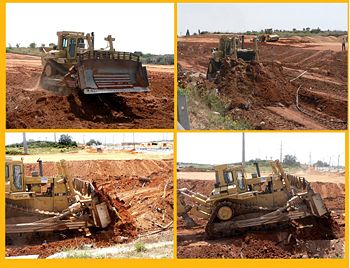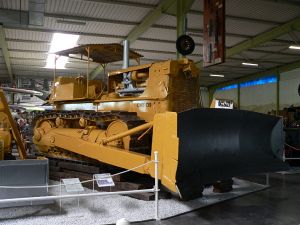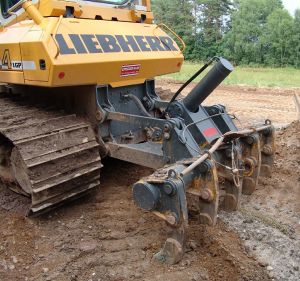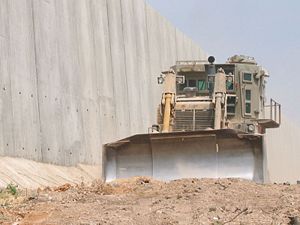Bulldozer
A bulldozer is a very powerful crawler (caterpillar tracked tractor) equipped with a blade. The term "bulldozer" is often used to mean any heavy engineering vehicle, but precisely, the term refers only to a tractor (usually tracked) fitted with a dozer blade. That is the meaning used here.
Bulldozers can be found at construction sites, mines, roadsides, military bases, heavy industry factories, and large governmental projects. They have been modified over time to produce new machines, such as the loader tractor. A very small bulldozer, sometimes called a calfdozer, is useful for operation in small work areas such as mines. Nevertheless, the original, earthmoving bulldozers are still irreplaceable, as their tasks are concentrated in deforestation, earthmoving, ground leveling, and road carving.
History
The first bulldozers were adapted from farm Holt tractors that were used to plow fields. Given their versatility in soft ground for logging and road building, they were used as armored tanks during the First World War.
By the 1920s, tracked vehicles became common, particularly the Caterpillar 60. To dig canals, raise earth dams, and do other earth-moving jobs, these tractors were equipped with a large, thick metal plate in front. This plate (later curved in shape) is called a "blade." The blade peels off layers of soil and pushes it forward as the tractor advances. Several specialized blades have been developed: For high volume loads such as coal, rakes to remove large boulders, or blades with razor-sharp edges to cut tree stumps. In some early models, the driver sat on top in the open without a cabin.
The attachments, built at home or by small equipment manufacturers, appeared as early as 1929, but the blades were known as "bull-grader" blades. The term "bulldozer blade" does not appear to have come into widespread use until the mid-1930s. The addition of powered-down force made them the preferred excavation machine for large and small contractors alike by the 1940s. By then, the term "bulldozer" referred to the entire machine and not just the attachment.
Over the years, when engineers needed equipment to complete large-scale earthworks, a number of firms—including CAT, Komatsu, Fiat-Allis, John Deere, International Harvester, Case, Liebherr, Terex, and JCB—started to manufacture large, tracked-type earthmoving machines. They were large, noisy, and powerful, and therefore nicknamed "bulldozers."
Through the years, bulldozers got bigger, more powerful, and more sophisticated. Important improvements include more powerful engines, more reliable drive trains, better tracks, and raised cabins. In addition, hydraulic arms (instead of the cable-operated arms of early models) have enabled more precise manipulation of the blade and automated controls. As an option, bulldozers can be equipped with a rear ripper claw to loosen rocky soils or break up paved roads.
The best-known maker of bulldozers is probably the Caterpillar Tractor Company, which earned its reputation for making tough, durable, reliable machines. Although these machines began as modified farm tractors, they became the mainstay for big civil construction projects, and found their way into use by military construction units throughout the world. Their best known model, the Caterpillar D9, was also used to clear minefields and demolish enemy structures.
History of the word
- Around 1880, in the U.S., a "bull-dose" was a large, efficient dose of any type of medicine or punishment. "Bull-dosing" meant a severe whipping, coercion, or other form of intimidation, such as at gunpoint.
- In 1886, the term "bulldozer" was applied to a large-caliber pistol and the person who wielded it.
- In the late 1800s, "bulldozing" meant using great force to push over or through any obstacle.
- Later, the term was applied to the vehicle.
Description
Most often, bulldozers are large, powerful, tracked engineering vehicles. The tracks give them excellent ground hold and mobility through very rough terrain. Wide tracks help distribute the bulldozer's weight over a large area, decreasing the pressure on the surface. This prevents the bulldozer from sinking in sandy or muddy ground. Extra-wide tracks are known as "swamp tracks."
Bulldozers have excellent ground hold and a torque divider designed to convert the engine's power into dragging ability, letting the bulldozer use its own weight to push very heavy things and remove obstacles that are stuck in the ground. The Caterpillar D9, for example, can easily tow tanks that weigh more than 70 tons. Because of these attributes, bulldozers are used to clear areas of obstacles, shrubbery, burnt vehicles, and remains of structures.
Sometimes a bulldozer is used to push another piece of earthmoving equipment, known as a "scraper." The towed Fresno Scraper, invented in 1883, by James Porteous, was the first design to enable this to be done economically, removing the soil from the cut and depositing it elsewhere on shallow ground (fill). Many dozer blades have a reinforced center section with this purpose in mind, and are called "bull blades."
The bulldozer's primary tools are the blade and the ripper.
Ripper
The ripper is the long claw-like device on the back of the bulldozer. Rippers can come singly (single-shank) or in groups or two or more (multi-shank rippers). Usually, a single shank is preferred for heavy ripping. The ripper shank is fitted with a replaceable tungsten steel alloy tip.
Ripping rock lets the ground surface rock be broken into small rubble easy to handle and transport, which can then be removed so grading can take place. Agricultural ripping allows workers to break up rocky or very hard earth, so that land that was once very difficult to plow can be farmed. For example, much of the very best land in the California wine country consists of old lava flows: With heavy bulldozers such as the Caterpillar D9 and the Caterpillar D11, the lava is shattered allowing practical agriculture for the wine industry. Also, hard earth can be ripped and de-compacted to allow the planting of orchards that otherwise would not have grown on the land.
Blade
The bulldozer blade is a piece of heavy metal plate, installed on the front of the tractor, with the aim of pushing things, handling rough obstacles, and shoving sand, dirt, and debris. The dozer blade on front of the tractor usually comes in 3 varieties:
- A Straight Blade ("S-Blade") which is short and has no lateral curve, no side wings, and can be used for fine grading.
- A Universal Blade ("U-Blade") which is tall and very curved, and has large side wings to carry more material.
- An "S-U" combination blade which is shorter, has less curvature, and smaller side wings. This blade is typically used for pushing piles of large rocks, such as at a quarry.
In military use, dozer blades are fixed on combat engineering vehicles and can optionally be fitted on other vehicles, such as artillery tractors, like the Type 73 or M8 Tractor. Combat applications for dozer blades include clearing battlefield obstacles and preparing fire positions.
Modifications
Bulldozers have been further modified over time to evolve into new machines which are capable of working in ways that the original bulldozer can not. One example is that loader tractors were created by removing the blade and substituting a large volume bucket and hydraulic arms which can raise and lower the bucket, thus making it useful for scooping up earth and loading it into trucks.
Other modifications to the original bulldozer include making it smaller to let it operate in small work areas where movement is limited, such as in mining. A very small bulldozer is sometimes called a calfdozer.
Nevertheless, the original earthmoving bulldozers are still irreplaceable as their tasks are concentrated in deforestation, earthmoving, ground leveling, and road carving. The heavy bulldozers are mainly employed to level the terrain to make it fit to construct on. The construction, however, is mainly done by small bulldozers and loader tractors.
Uses
Bulldozers can be found on large and small-scale construction sites, mines, roadsides, military bases, heavy industry factories, and large governmental projects.
Some bulldozers, especially those in military use, have been fitted with armor, to protect the driver from enemy fire, thus enabling the bulldozer to operate in battle zones. The most famous armored bulldozer is probably the IDF Caterpillar D9, used by the Israeli Defense Forces (IDF) for detonating explosive charges and demolishing structures under fire. Caterpillar does not make or install the armor—that is entirely IDF's work. However, various users, including the U.S. military, buy armor kits from the IDF and fit them onto their own D9s. The design varies, but the armor kit on average adds 10 tonnes to the weight of the bulldozer, which weighs about 49 metric tons without the armor.
Some bulldozers have been fitted with armor by non-government civilian operators to prevent people from interfering with the work performed by the bulldozer.
ReferencesISBN links support NWE through referral fees
- Butterfield, Moira, Chris Lyon, and Gary Biggin. 1995. Bulldozers and Other Construction Machines. Richmond Hill, ON: Scholastic Canada. ISBN 0590245562
- Pripps, Robert N. 2000. The Big Book of Caterpillar: The Complete History of Caterpillar Bulldozers and Tractors, Plus Collectibles, Sales Memorabilia, and Brochures. Stillwater, MN: Voyageur Press.
- Schaufelberger, John. 1999. Construction Equipment Management. Upper Saddle River, NJ: Prentice Hall. ISBN 0137162677
- Trewhitt, Philip. 1998. Armoured Fighting Vehicles. Dempsey-Parr. ISBN 1840843284
External links
All links retrieved December 21, 2016.
- My Universe: Construction Zone. (Quick Reference Equipment Specs).
- Van Natta Bulldozers.
Credits
New World Encyclopedia writers and editors rewrote and completed the Wikipedia article in accordance with New World Encyclopedia standards. This article abides by terms of the Creative Commons CC-by-sa 3.0 License (CC-by-sa), which may be used and disseminated with proper attribution. Credit is due under the terms of this license that can reference both the New World Encyclopedia contributors and the selfless volunteer contributors of the Wikimedia Foundation. To cite this article click here for a list of acceptable citing formats.The history of earlier contributions by wikipedians is accessible to researchers here:
The history of this article since it was imported to New World Encyclopedia:
Note: Some restrictions may apply to use of individual images which are separately licensed.



